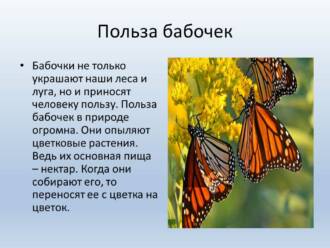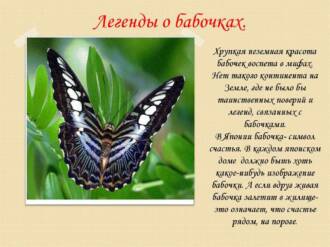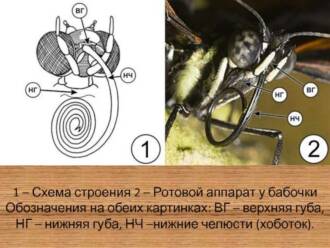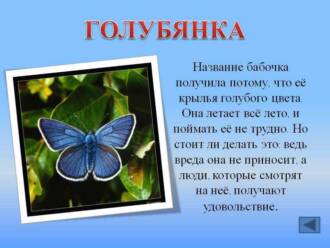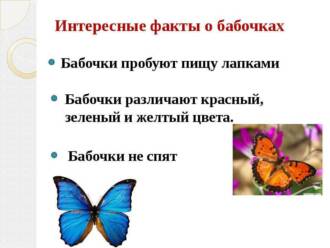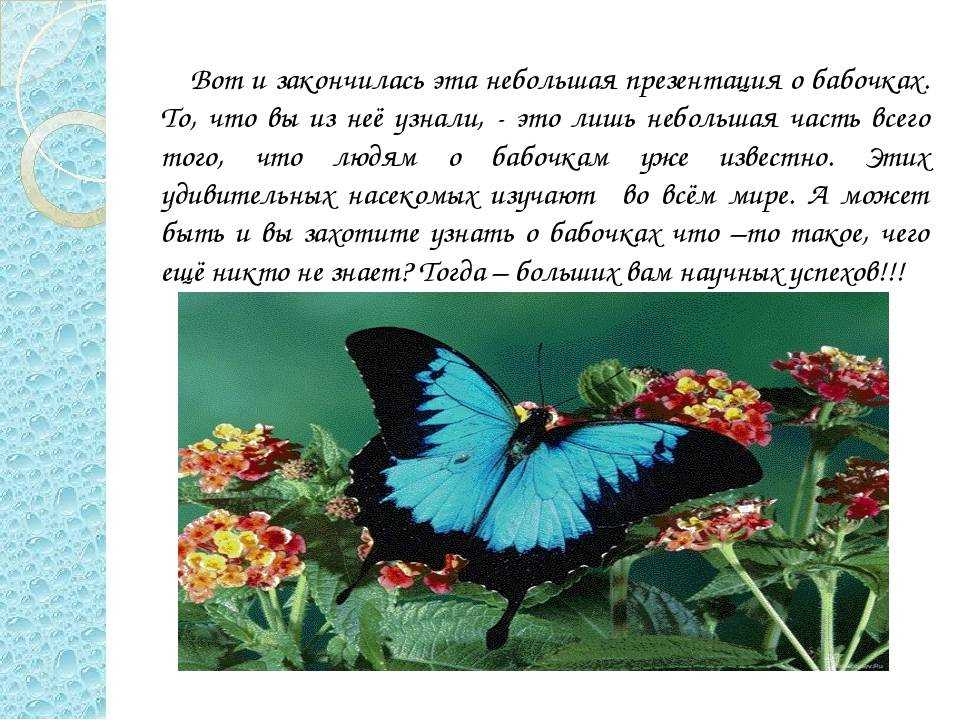
Butterflies are beautiful creatures that attract attention with their beauty and ease of flight. In this short story, we will talk about the life of butterflies and their amazing features.
Butterflies are insects that go through several stages of development: egg, caterpillar, pupa and adult. Each stage has its own characteristics. For example, caterpillars feed on plants and come in a variety of colors and shapes. However, the most interesting stage is the pupal stage. A chrysalis is a special protective shell in which a caterpillar turns into a butterfly. This process is called metamorphosis.
Butterflies come in a huge variety of colors and shapes. They can be bright and colorful, as well as have different patterns on their wings. Each type of butterfly has its own unique traits. For example, a peacock butterfly has eyes on its wings that help it scare away predators, and a tropical moth can be so small that it can be compared to the head of a pin.
A story about a butterfly for children is a great way to introduce them to the wonderful world of nature. Butterflies are not only beautiful, but also play an important ecological role - they carry pollen between flowers, contributing to pollination and reproduction of plants. By learning this, children can better understand why protecting butterflies and their habitats is so important to our planet.
In the world of butterflies: their diversity and features
Butterflies are amazing insects that attract attention with their beauty and tenderness. Each butterfly has its own unique shape and color of wings, which makes them truly special. No butterfly is like another.
There are a huge number of species of butterflies in the world. Their diversity is amazing: from small and inconspicuous to huge and bright. Each type of butterfly has its own specifics and lifestyle.
Fun fact: Butterflies are one of the most beautiful and colorful insects on the planet. They are capable of flying long distances, overcoming obstacles and traveling from one place to another.
Butterfly story for kids
For children, short stories about butterflies are especially interesting. They can learn a lot of new and exciting things about the life of these beautiful insects. For example, toddlers will be interested to know that butterflies have sensitive antennae that help them find food and navigate in space.
It will also be interesting for children to learn about the process of turning a butterfly from a caterpillar. The caterpillar builds a cocoon for itself, in which a transformation takes place: it turns into a chrysalis, and then a beautiful butterfly emerges from the chrysalis.
Butterflies play an important role in nature. They are pollinators of plants, helping them to reproduce. Without butterflies, many plant species would not be able to survive.
In Russian folk culture, butterflies are often associated with lightness and freedom. Their wings resemble delicate handkerchiefs that float in the air. Butterflies can be symbols of beauty, transformation and change.
Amazing variety of butterflies

Butterflies are beautiful and amazing creatures of nature. Each type of butterfly has its own unique features and beauty. In this story about butterflies for children, we will dive into the world of the diversity of these beautiful insects and learn a lot of interesting things about their life.
Let's start a short story about a butterfly by saying that they belong to the class of insects and are one of its most beautiful representatives. Butterflies have a variety of wing colors, which can include the brightest colors and shades. Some types of butterflies can change the color of their wings depending on the external conditions, which makes them even more amazing.
Butterflies impress with their variety of shapes and sizes. Some species of butterflies have large wings that can be wider than their body length. Others, on the contrary, have small wings, but compensate for this with their beautiful coloration. Interestingly, in some species of butterflies, the wings can be transparent or have an irregular shape, which helps them to camouflage themselves and avoid danger.
Butterfly life cycle
A short story about a butterfly begins with its life cycle, which goes through several stages. This butterfly story for kids will help them learn about the miraculous process of turning a caterpillar into a beautiful butterfly.
At the beginning of its life, the butterfly is in the form of an egg. Eggs can be of different sizes and shapes, depending on the type of butterfly. When the egg hatches, a caterpillar emerges from it. The caterpillar is the first stage in the life cycle of butterflies. The caterpillar eats the leaves and gradually grows.
After the caterpillar reaches a certain size, it turns into a chrysalis. The pupa is the second stage in the life cycle of butterflies. Amazing changes take place inside the chrysalis: the caterpillar turns into a butterfly. This process is called metamorphosis.
When the butterfly is fully formed, it flies out of the chrysalis. Now the butterfly is ready for its new life. She flies and searches for food to sustain her energy. Butterflies usually live only a few weeks or months, so their lifespan is very short.
Metamorphosis: from caterpillar to butterfly
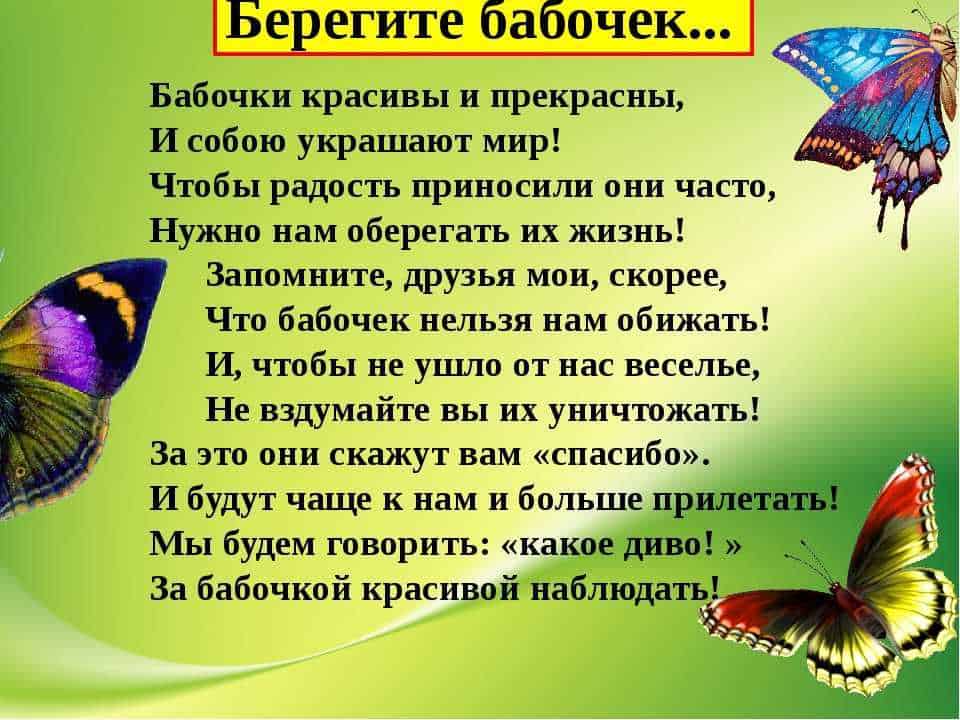
A story about butterflies for children always arouses interest and surprise. One of the most amazing phenomena in the life of butterflies is their metamorphosis. This amazing transformation begins with an egg that the female lays on a plant leaf. A caterpillar hatches from the egg - a small creature that begins to actively feed and grow.
A caterpillar story about a butterfly for children can learn that it has many legs and lives mainly on one plant, which serves as its food. The caterpillar constantly eats and grows until it reaches a certain size. Then there comes a time when the caterpillar stops eating and begins to prepare for its last stage.
At this stage, the most amazing part of the metamorphosis occurs - the caterpillar turns into a chrysalis. It weaves its thread and creates a special shell, inside which incredible changes occur. Inside the chrysalis, the caterpillar is transformed into a butterfly. Over the course of several weeks, complex development processes occur, and finally, the chrysalis splits and an adult butterfly flies out.
Butterfly story for kids can learn that she has wings that allow her to fly. Butterfly wings come in many colors and patterns, and they serve not only to fly, but also to attract the attention of other butterflies and scare away predators. Butterflies also have long mouthparts that allow them to feed on the nectar of flowers.
Variety of colors and patterns
Butterflies are one of the most beautiful and diverse creatures in the natural world. Their coloring and patterns on the wings amaze the imagination and are admired by adults and children. In a story about butterflies for children, you can talk about the amazing color and pattern options that can be found on their wings.
Each type of butterfly has its own unique pattern of coloration and patterns. Some butterflies have a bright and saturated coloration, consisting of different colors, such as blue, red, yellow and green. Other butterflies can be pastel and delicate, with lighter shades of pink, purple and blue. There are also types of butterflies with a metallic sheen that changes depending on the lighting.
The patterns on the wings of butterflies are also very diverse. Some butterflies have simple and geometric patterns consisting of lines, dots and circles. Other butterflies may have intricate and elaborate patterns that resemble flowers, plants, or animals. The patterns on butterfly wings can be symmetrical or asymmetrical, which makes them even more beautiful and unique.
A story about a butterfly for children is a great opportunity to get acquainted with the variety of colors and patterns on the wings of these incredible insects. Showing children pictures of different types of butterflies and explaining how they differ in color and patterns can develop their imagination and interest in nature.
Features of the wings and their functions
Butterfly wings are one of the most amazing and important features of these delicate insects. They serve not only for flight, but also perform a number of other functions.
Protection
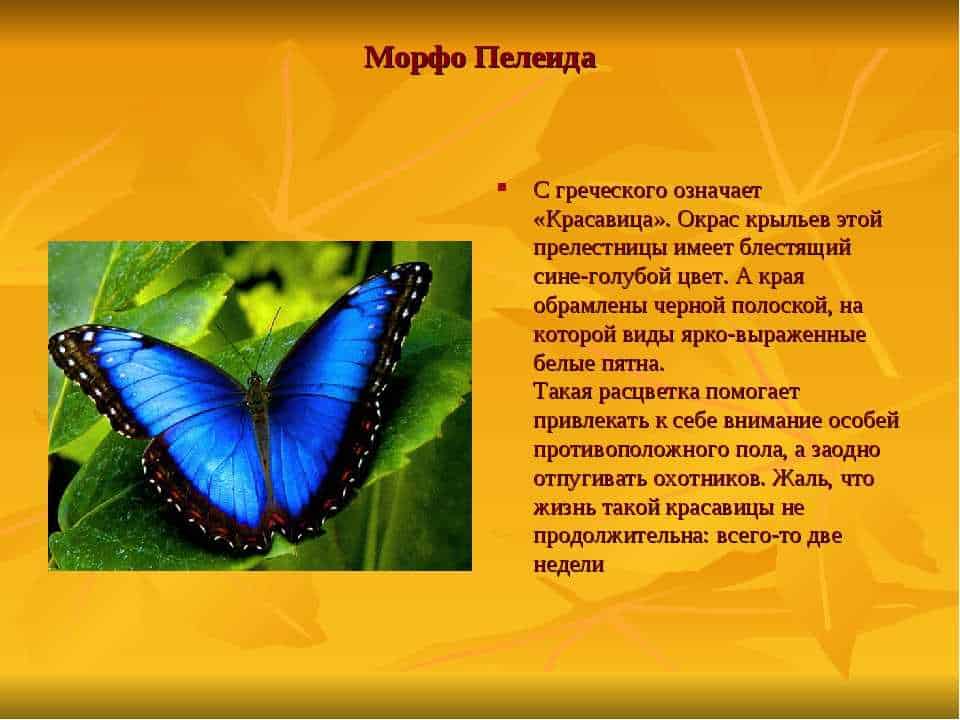
Butterfly wings come in a variety of colors and patterns that help them camouflage themselves against their surroundings and avoid danger. Some species have wings with camouflage patterns that make them indistinguishable from trees and shrubs. Other butterflies have brightly colored wings that warn predators that they are poisonous and dangerous to eat.
sexual reproduction
Butterfly wings also play an important role in the process of sexual reproduction. Males often have pheromones on their wings, special substances that attract females and help them find a mating partner. In addition, in some species, wings may have patterns that serve to determine the sex and age of butterflies.
Thus, butterfly wings perform a number of important functions, helping them survive in the harsh natural world and reproduce to preserve their species.
Butterfly migrations: long journeys
Butterflies are amazing creatures of nature that are capable of traveling far. Butterfly migrations are real adventures that happen every year. They can fly thousands of kilometers to find a suitable place to breed and find food.
The story about butterflies for children is interesting and exciting. Children can learn that butterflies migrate in large groups called “colonies”. They fly together to increase their chances of survival and reaching their destination. During their journey, butterflies use various landmarks such as mountains, rivers and lakes to find their way.
A short story about a butterfly can teach children that one of the most famous examples of butterfly migration is the migration of monarchs. Every year, millions of monarchs from North America go on a long journey to Mexico, where they will spend the winter. They then return north to breed and continue their life cycle.
An interesting fact about butterfly migration is that they use the sun's rays to navigate. Butterflies use the position of the sun to determine their path. They can also use the Earth's magnetic field and smells to find their way. All this makes butterfly migrations truly amazing and mysterious.
Food preferences: what do butterflies eat?

In a story about butterflies for children, it is necessary to mention their food preferences. The variety of butterflies is also reflected in their diet.
Plant food

Most butterflies are herbivorous insects. They feed on the nectar of flowers and plant juices. Flower nectar is the main food source for most butterfly species. They use their proboscises to suck nectar from flowers. Nectar contains sugars that provide energy for butterflies to fly and reproduce.
host plants
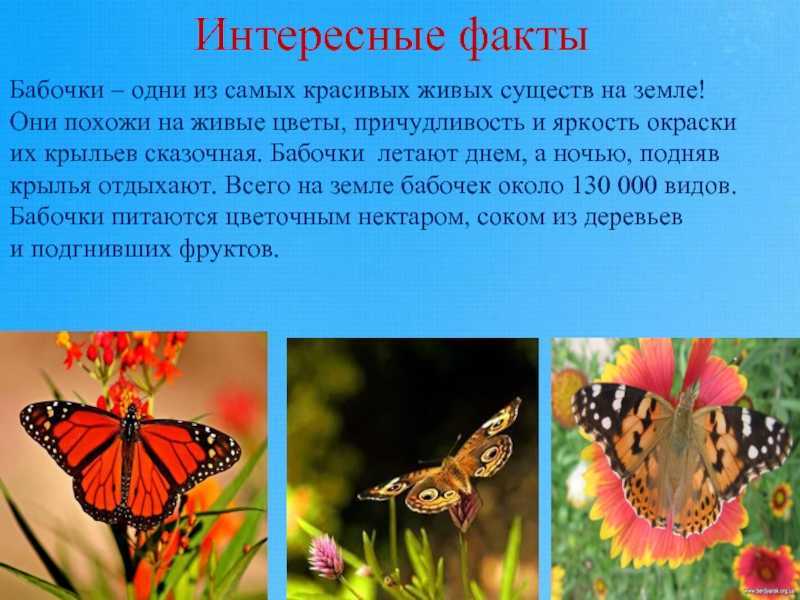
Some species of butterflies prefer to eat not only the nectar of flowers, but also the juices of plants. They lay their eggs on specific host plants that their caterpillars will feed on. Butterfly caterpillars may feed on the leaves, stems, or flowers of their host plants. Some butterfly species have a narrow food preference and can only feed on certain types of plants.
A story about a butterfly for children should include information that the food preferences of butterflies may differ depending on their species and habitat. Studying the feeding habits of butterflies is an important part of studying their life and diversity.
Interaction with plants and other animals
Butterflies interact with plants and other animals during their life cycle. They play an important role in plant pollination by carrying pollen from one flower to another. When a butterfly lands on a flower, it drinks nectar, which contains sugars and other nutrients. In return, the butterfly carries the pollen from the flower to its legs and body, and when it flies to another flower, the pollen lands on it and aids in pollination. In this way, butterflies help plants reproduce and continue their growth and development.
In addition to pollination, butterflies interact with other animals. Some species of butterflies feed on plants, and their larvae can be important links in an ecosystem. For example, morpho butterfly larvae feed on plant leaves, and their presence on a plant can attract predators such as birds or ants, which can also be food for other animals.
A story about a butterfly for children allows you to understand how important the interaction of butterflies with plants and other animals in nature. Butterflies are an integral part of the ecosystem and perform important functions influencing the diversity and health of plants and animals.
The role of butterflies in ecosystems and their importance to nature
Butterflies play an important role in ecosystems and are an integral part of nature. They perform many functions that are beneficial to the environment and other living organisms. A story about butterflies for children will help them understand how important it is to preserve and protect these beautiful insects.
Pollination of plants
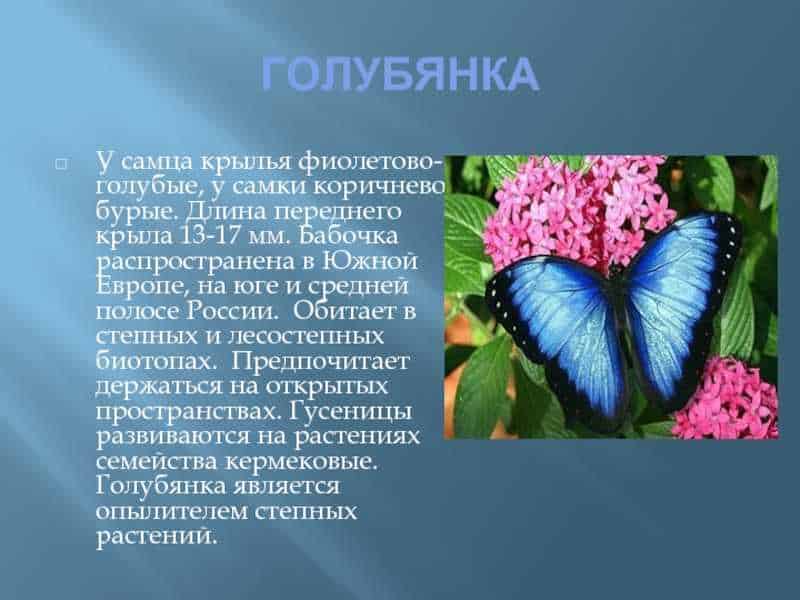
One of the main functions of butterflies is to pollinate plants. When a butterfly visits a flower, it transfers pollen from one flower to another, helping to fertilize the plants. This allows the plants to multiply and form new fruits and seeds. Thus, butterflies play an important role in maintaining the diversity of the plant world.
Food for other animals
Butterflies are also a food source for many other animals. Many birds, lizards and frogs feed on butterflies and their caterpillars. Because of this, butterflies are part of the food chain and help keep the ecosystem in balance. Butterflies story for children will help them understand that they are not only beautiful creatures, but also important links in nature.
Ecological Status Indicators
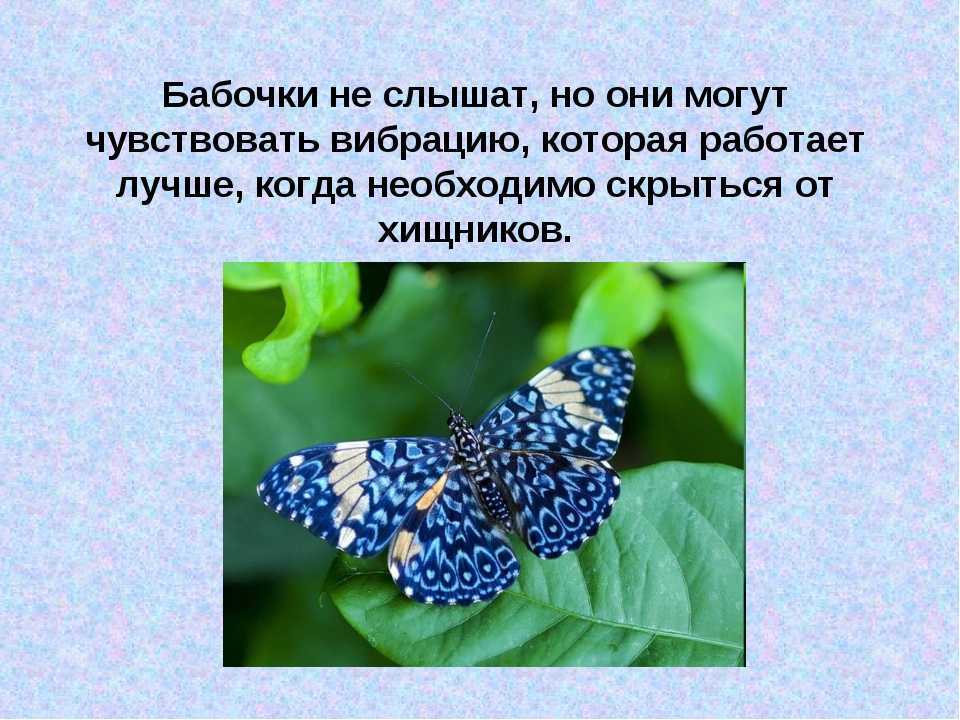
Butterflies can also serve as indicators of ecological status. Changes in the abundance and diversity of butterflies can indicate changes in an ecosystem. If butterflies begin to disappear or become less diverse, this may be a sign of adverse environmental changes such as pollution or habitat loss. Therefore, the conservation and protection of butterflies is an important task for maintaining the natural balance.
A story about a butterfly for children will help them understand the importance of these beautiful insects and instill in them care for nature and the environment.

